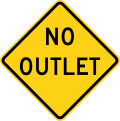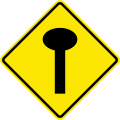dead end
In a dead end (alternatively cul) is one for local traffic certain road , which is accessible only from one end.
The term “dead end” arose because the street, like a sack, has only one opening; The input and output are therefore identical. In the Middle Ages , the dead end was also called "Kehrwiedergasse". So-called dead - end villages developed around them . This is a special village form of settlement along dead ends, as an extension of Rundlingen .
In the English-speaking world, in addition to the term dead end street , the French loan word cul-de-sac is used for dead ends ; at the same time, this name also describes the characteristics of a type of settlement in the suburbs.
The railways are dead ends in the rail network as a stump track called. A train station whose tracks end in the train station is called a terminal station , colloquially it is also called a dead end station.
In a figurative sense, the term dead end is also used colloquially for hopeless situations or efforts that do not lead to the desired solution.
features

Dead ends have various advantages and disadvantages. They primarily serve to calm traffic , as through traffic and stealth traffic are effectively excluded. In the case of short dead ends, it is also advantageous that there is only a small number of vehicles due to the few residents.
The disadvantage is the large amount of space required if a turning system is built at the end of a dead end , which is often done in order to improve the drivability, especially for garbage and fire trucks. Another problem is that properties that are connected to the road network in only one direction are cut off in the event of a road closure. Another disadvantage is that the surrounding main and collecting roads have to absorb more traffic. In addition, there may be longer detours. For this reason, connecting routes are often created that make dead ends for pedestrians and cyclists ("road users who are sensitive to detour") in the pedestrian and bicycle traffic network . This is almost standard in European local road networks, whereas it is largely absent in North America.
Signage
In order to notify the road user that he is driving or walking into a dead end, the Road Traffic Act and the regulations of the respective states specified therein provide for appropriate signage. In many states, the corresponding road sign is blue with a stylized white path that is bordered by a red crossbar at the end. If certain vehicles (usually trucks) cannot turn around , this can also be indicated by an additional sign .
Germany
In Germany, in Appendix 3 to Section 42 (2) StVO, the sign 357 "Dead end" is listed under No. 27. According to VwV-StVO , the sign should only be used if the road is not easily recognizable as a dead end. With the amendment of the road traffic regulations in 2009, a sign of the permeable cul-de-sac for pedestrians and cyclists (signs 357-50) and the permeable cul-de-sac for pedestrians (signs 357-51) or cyclists (signs 357-52) were also introduced.
Austria
Under Section 53 of the Austrian road traffic regulations , point 11 shows the “dead end” sign. It indicates that it is not possible to drive through a street.
Switzerland and Liechtenstein
In Switzerland and Liechtenstein, the “dead end” signal (4.09) marks a road that is not continuously passable (Switzerland: Art. 46 SSV ). "If a path for pedestrians or cyclists continues at the end of the street, the signal can be supplemented with the appropriate symbols ('dead end with exceptions'; 4.09.1)", Paragraph 3 continues.
Illustration (DACH countries)
In many countries there are also traffic signs to announce a dead end at the next intersection.
- Announcement of a dead end diagonally to the right ( Italy )
- Announcement of a dead end on the left ( Singapore )
- Announcement of a dead end on the right ( Netherlands )
- Advance notice of a dead end following an intersection ( Spain )
- Announcement of a dead-end street on the left for cyclists ( Norway )
Signs with text
Signs with text are used in various English-speaking countries. The US Federal Highway Administration states that the “Dead End” sign should be used at the entrance to a single cul-de-sac, while the “No Outlet” sign should be used at the entrance to a street or network of streets from which there is no other exit. There is no nationwide regulation for the term “No Exit”. There are also different signs in individual states.
- "Dead End" ( Australia )
- "No Exit" ( New Zealand )
- "Dead End" ( USA )
- "Loop Street" / "Wendestrasse" ( Pennsylvania )
Selection of signs from other countries with different colors or shapes
In South Africa the pictogram for dead end on a green background is usually used. In contrast, a sign with a yellow background is used for temporary dead ends, for example during construction work.
- Dead End ( Jamaica )
- Dead End ( United Arab Emirates )
- Dead End (Canada / Prince Edward Island )
- Dead End ( Ireland )
Special signage
Traffic signs to the turning area for cars on the dead end street (in front of the tram and pedestrian zone) in Prague
Seasonal dead end through a rivier in South Africa
Historical signs
Web links
Individual evidence
- ↑ Pierer's Lexicon 1857
- ↑ Georges Lexicon 1910
- ^ Johannes Meyer: Sustainable city and traffic planning . Springer Verlag, Düsseldorf 2012, ISBN 3-8348-2410-0 , p. 114 .
- ↑ Annex 3 (to § 42 paragraph 2) StVO. Directional sign. Federal Ministry of Justice, 2009, accessed on September 19, 2015 .
- ↑ General administrative regulation for road traffic regulations (VwV-StVO). October 22, 1998, Retrieved December 29, 2012 (Section: Regarding Sign 357 Dead End).
- ↑ Uli Korsch: Guidelines for Securing Workplaces on Roads RSA-95 (overview of old and new traffic signs). Archived from the original on January 12, 2012 ; Retrieved December 29, 2012 (characters 357, 357-50 and 357-51).
- ^ Road traffic regulations of 1960 in the version of February 5, 2013
- ^ William Safire : On Language: Dead End. New York Times, July 13, 2008, accessed December 31, 2012 .
- ^ Traffic Signs of South Africa. Arrive allive, accessed December 31, 2012 .
- ↑ Your Driver License, Chapter 3: Traffic Signs. (PDF; 2.4 MB) Prince Edward Island, accessed on December 31, 2012 (English).






























